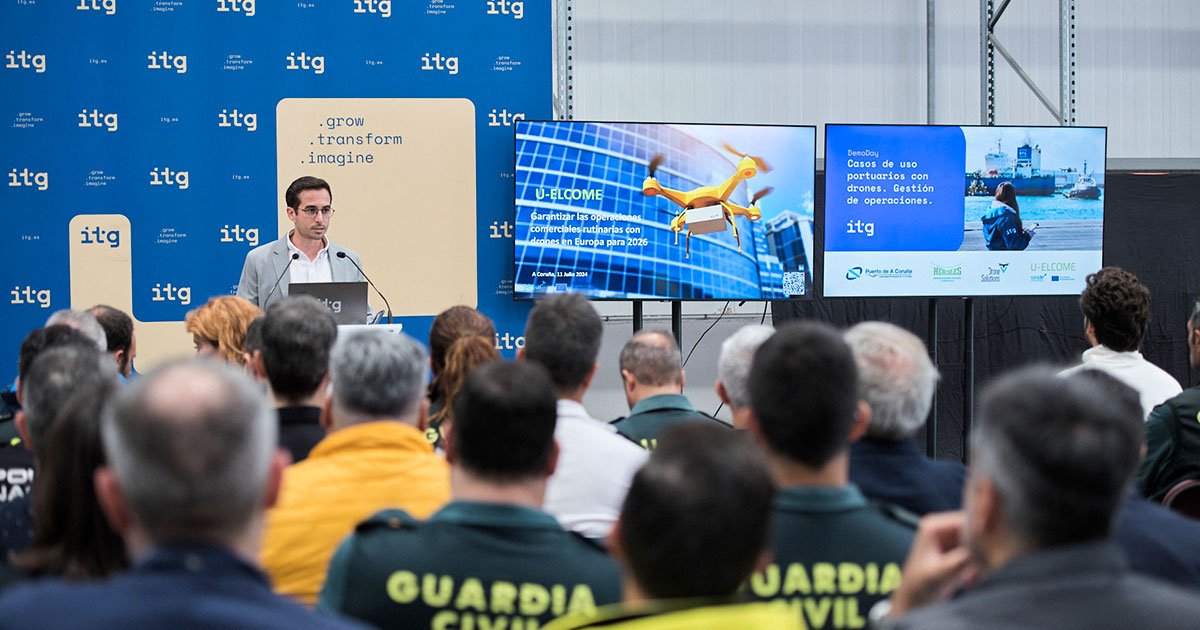The technology developed by ITG for autonomous drone operations and their safe integration into the airspace, through its platforms DroneSuite®️ and Daliah, was put into practice at this event, which counted with the collaboration of the Red Cross Maritime Rescue and drone operator companies such as Aeromedia, Aerocámaras and Nordés Tech.
ITG’s technology will allow automated traffic of unmanned aerial vehicles (UAVs) in 2026. By that date, A Coruña will be one of the pioneering cities in Spain to deploy U-Space zones that meet all the regulatory requirements and technology necessary for a large number of drone operators to deploy their operations in a simultaneous, coordinated, and automated manner.
The President of the Port Authority of A Coruña, Martín Fernández Prado, values all the innovative work that ITG is developing in this field. “The use of drones for the surveillance service and for the supervision of port infrastructures and operations will be very useful in the ports in the coming years, and this collaboration with the ITG Technology Centre will allow us to incorporate them in the short term in our daily work with a total guarantee of safety and efficiency,” he pointed out.
Demonstration of the Use of Drones in Ports: Rescue of a Person at Sea
Practical demonstrations were carried out of six cases of use with autonomous drones, which form part of the list of twenty already identified and analyzed during previous work in recent months. In this way, an autonomous drone took off simulating a routine surveillance operation in which a person fallen into the sea is detected and various drone operations associated with their rescue are activated.
Localization with DroneFinder technology allows the exact coordinates to be sent so that another drone can launch a float to the person who has fallen into the water, and a maritime drone can travel to that point and bring the victim to the dock. There were also demonstrations of crane, parameter and breakwater inspection, port logistics, non-collaborative drone detection, and how ITG technology works to obtain authorizations for simultaneous integrated and safe flight of drones performing these services.
The conference, which was attended by representatives of the public entities INECO, ENAIRE, SENASA, the Coastguard Service or the Military Emergency Unit, and companies such as Telefónica and MGS, among others, had the collaboration of the Port Authority of A Coruña and Hércules Servicios Auxiliares, Portuarios y Logísticos, concessionaire of the outer port in whose ship the explanations prior to the demonstrations took place. The ITG Technology Centre recently reached an agreement with the Port Authority of A Coruña to deploy the first autonomous drone station in the Outer Port, a robotized hangar called DroneSafeBox®️ that will allow the management of operations such as the control of goods, the use of spaces, loading and unloading operations or surveillance, and even the transport of objects.
This “nest” for drones is the first station of its kind to be set up permanently in a port environment in Spain and will enable the technology to be integrated into the port’s processes with a view to its future commercial exploitation. The operations of the pioneering station in Langosteira will be planned and programmed from GalaxyLab, ITG’s control center located in a separate building in Cidade das TIC.
ITG, a European Benchmark in Drone Technology
The ITG Technology Centre is one of the relevant agents in Europe for research and development in the drone field, developing technologies for the automation and safe integration of operations in urban environments. It leads working groups in EUROCAE (European Organization for Civil Aviation Equipment), EUROCONTROL (European Network of U-space Demonstrators) and AME (Alliance for New Mobilit Europe), and has participated in major European demonstrators such as H2020 AMU-LED, which in September 2022 involved a pioneering test of unmanned air taxi service in Galicia, or U-ELCOME, in which the tests that took place today are framed.
U-ELCOME is a 3-year SESAR Digital Sky Demonstrator project involving 51 partners whose overall aim is to support the market uptake of U1 and U2 services. With demonstrations taking place in three European countries, the project aims to develop interoperability and support EU harmonization of U-space services. Taking into consideration the various U-Space actors and stakeholders, this project values collaboration and information-sharing. Join us to find out more about the research project, what activities are planned, and how the project hopes to make U-space a European reality.

